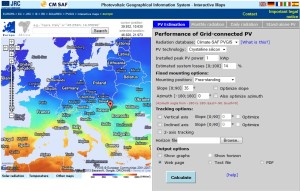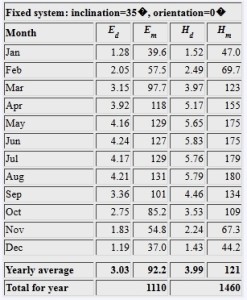PVGIS: A Comprehensive Solar Panel Calculator for Photovoltaic Systems
In other posts, we've told you quite a bit about our own solar energy calculator, WhatNextNow Solar Discover. Now, we're going to take a look at PVGIS.
PVGIS is an online solar panel calculator funded by the European Commission and developed by the Joint Research Centre in Italy. PVGIS can be used to determine the expected performance of grid-connected or off-grid photovoltaic systems. A map-driven user interface enables the users to select the location of interest. Once the location is determined, various system specifications can be modeled using drop-down menus and tick boxes. These specifications include installed power capacity, estimated system losses, panel mounting type (fixed vs. tracking) and other options. If you are designing an off-grid PV system, the "Stand-alone PV" option can be a useful feature to determine the optimal capacity of a battery bank. Users can also select various output options for displaying the results, including graphs, text-only and pdf formats. Once the users make their selections, clicking on the "Calculate" button runs the performance analysis. The results of PVGIS are presented within a table and on two optional graphs.

PVGIS user interface
In addition to PV performance estimates, PVGIS also gives the users the option to take a more detailed look at the solar resource at monthly and daily scales. The daily values are given for a "typical day" in the month as opposed to every single day in the month. While this may seem a bit arbitrary, it's actually a quite common way to summarize solar radiation data. Solar resource data include various climate variables at the selected site, such as air temperature averages as well as solar radiation components (e.g., direct and diffuse). Users should keep in mind that both the PV performance data and the climate variables are long-term averages and they do not represent what actually happened at the selected site in recent weeks or months.
Geographical Coverage
PVGIS provides coverage in two main regions: Europe and Africa. The European zone extends to some parts of North Africa and the Middle East. The African zone also includes the Arabian Peninsula and Iran. The coverage area is limited by the footprints of the European meteorological satellites used to develop PVGIS.
Our Verdict on PVGIS
PVGIS is a very useful calculator if you've already mastered the basics of solar energy. The level of technical detail and a myriad options can render it a powerful tool in the hands of a solar industry pro. The detailed calculations of solar radiation, the ability to analyze both grid-connected and off-grid PV systems and various analysis output options are all interesting features.

PVGIS results table
However, both the user interface as well as the analysis results are not very accessible for most homeowners. Although the accompanying documentation covers many areas, the level of technical detail can be intimidating to many. Interpreting the analysis results is a challenge by itself, as some of the key metrics are hard to identify. For example, in order to find your annual total electricity generation, you have to scan to the end of the output table and determine which of the annual totals is the one that really matters. Another drawback is the limited geographical coverage. If your site is located outside Europe or Africa, you're out of luck: as we discussed above, PVGIS does not have global coverage. Putting the limited geographical coverage and the complicated user interface aside, one of the main drawbacks of PVGIS is the lack of financial metrics for PV systems. Without analyzing the economic benefits and costs of solar panels for homes, it's very difficult for homeowners to make a sound decision.
With its global coverage and focus on financial metrics, WhatNextNow Solar Discover can be a good alternative to PVGIS. If your site is within the coverage zone of PVGIS, we highly recommend that you compare the results of PVGIS with other alternatives as well. It is highly unlikely that different online solar calculators will give exactly the same results, but if they all point in the same direction, you will have more confidence in the results.